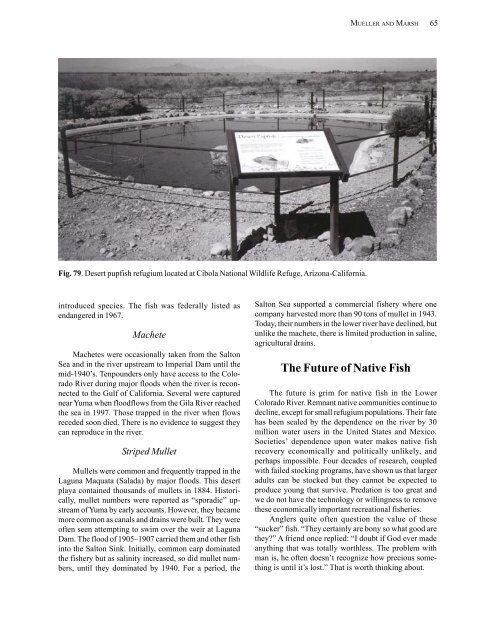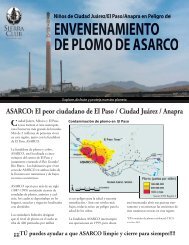Lost, A Desert River and its Native Fishes - Sierra Club
Lost, A Desert River and its Native Fishes - Sierra Club
Lost, A Desert River and its Native Fishes - Sierra Club
Create successful ePaper yourself
Turn your PDF publications into a flip-book with our unique Google optimized e-Paper software.
Fig. 79. <strong>Desert</strong> pupfish refugium located at Cibola National Wildlife Refuge, Arizona-California.<br />
introduced species. The fish was federally listed as<br />
endangered in 1967.<br />
Machete<br />
Machetes were occasionally taken from the Salton<br />
Sea <strong>and</strong> in the river upstream to Imperial Dam until the<br />
mid-1940‘s. Tenpounders only have access to the Colorado<br />
<strong>River</strong> during major floods when the river is reconnected<br />
to the Gulf of California. Several were captured<br />
near Yuma when floodflows from the Gila <strong>River</strong> reached<br />
the sea in 1997. Those trapped in the river when flows<br />
receded soon died. There is no evidence to suggest they<br />
can reproduce in the river.<br />
Striped Mullet<br />
Mullets were common <strong>and</strong> frequently trapped in the<br />
Laguna Maquata (Salada) by major floods. This desert<br />
playa contained thous<strong>and</strong>s of mullets in 1884. Historically,<br />
mullet numbers were reported as —sporadic“ upstream<br />
of Yuma by early accounts. However, they became<br />
more common as canals <strong>and</strong> drains were built. They were<br />
often seen attempting to swim over the weir at Laguna<br />
Dam. The flood of 1905œ1907 carried them <strong>and</strong> other fish<br />
into the Salton Sink. Initially, common carp dominated<br />
the fishery but as salinity increased, so did mullet numbers,<br />
until they dominated by 1940. For a period, the<br />
MUELLER AND MARSH 65<br />
Salton Sea supported a commercial fishery where one<br />
company harvested more than 90 tons of mullet in 1943.<br />
Today, their numbers in the lower river have declined, but<br />
unlike the machete, there is limited production in saline,<br />
agricultural drains.<br />
The Future of <strong>Native</strong> Fish<br />
The future is grim for native fish in the Lower<br />
Colorado <strong>River</strong>. Remnant native communities continue to<br />
decline, except for small refugium populations. Their fate<br />
has been sealed by the dependence on the river by 30<br />
million water users in the United States <strong>and</strong> Mexico.<br />
Societies‘ dependence upon water makes native fish<br />
recovery economically <strong>and</strong> politically unlikely, <strong>and</strong><br />
perhaps impossible. Four decades of research, coupled<br />
with failed stocking programs, have shown us that larger<br />
adults can be stocked but they cannot be expected to<br />
produce young that survive. Predation is too great <strong>and</strong><br />
we do not have the technology or willingness to remove<br />
these economically important recreational fisheries.<br />
Anglers quite often question the value of these<br />
—sucker“ fish. —They certainly are bony so what good are<br />
they?“ A friend once replied: —I doubt if God ever made<br />
anything that was totally worthless. The problem with<br />
man is, he often doesn‘t recognize how precious something<br />
is until it‘s lost.“ That is worth thinking about.














